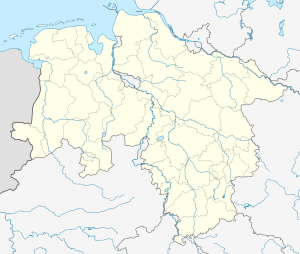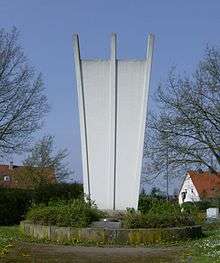Wietzenbruch
Wietzenbruch is a suburb in the southwest of the Lower Saxon town of Celle, which was named after the fen wood (Bruchwald) bisected by the river Wietze. Originally, the centre of Wietzenbruch was a small estate farm (v. Anderten).
Wietzenbruch | |
|---|---|
Stadtteil of Celle | |
Location of Wietzenbruch 
| |
 Wietzenbruch  Wietzenbruch | |
| Coordinates: 52°35′54″N 10°00′31″E | |
| Country | Germany |
| State | Lower Saxony |
| District | Celle |
| Town | Celle |
| Elevation | 38 m (125 ft) |
| Population (2008-01-01) | |
| • Total | 4,888 |
| Time zone | CET/CEST (UTC+1/+2) |
| Postal codes | 29225 |
| Dialling codes | 05141 |

Incorporation into Celle
Since 1974, Wietzenbruch has belonged entirely to the town of Celle (previously only part of it had been incorporated) and has become a popular housing development area.
Points of interest
The Wietzenbruch is also a description for the adjacent bog-like area in the direction of Großburgwedel. It was through this region that the first high-speed line for trial and record-breaking runs by railway locomotives was built during the 1920s. The track is also known as the Hare Railway (Hasenbahn) in the common parlance; a reference to its long construction time (1913–1938). Today, it forms part of the Hanover–Hamburg railway.

The Army aviation airfield (Heeresflugplatz Celle or Immelmann-Kaserne) in Celle-Wietzenbruch gained renown in the 1940s as one of the departure airfields for supply aircraft during the Berlin Airlift. This event is commemorated by the Airbridge Memorial at the entrance to the site initiated in 1985 by the then Celle town councillor, Karl Duffner, and opened in 1988. Today, the aerodrome is the location for the Bundeswehr's Army Aviation Training Centre C, as well as the 100th Aviation Reconnaissance Squadron (Heeresfliegerverbindungs- und Aufklärungsstaffel 100).
Politics
The head of the village council (Ortsbürgermeister) is Dr. Walter Jochim (CDU).